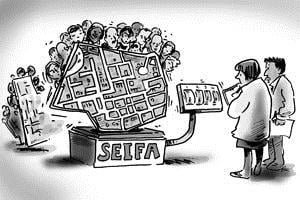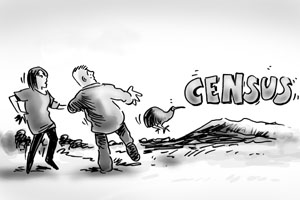The ABS has continued its habit of releasing significant results before major public holidays, by releasing the Socio-Economic Indexes for Areas (SEIFA) on March 28th, 2013, the day before the Easter break. The SEIFA results show an aggregate measure of Census characteristics pertaining to advantage and disadvantage in communities, and enables users to rank areas on a single scale. What do the results actually show?

Note that there are 4 indexes, but here I will be focussing on the Index of Advantage/Disadvantage. That is the index which measures both ends of the scale – extreme advantage and extreme disadvantage will push areas towards the top or bottom of the list. The more commonly used index is the Index of Disadvantage, which measures only the level of disadvantage prevalent in the area – and is the main one used for grant applications, and the one presented in profile.id. The two indexes give broadly similar rankings, but the exact score may differ from what we have on profile.id. If you need any of the other indexes please contact us at .id.
Australia
The national results reveal a changing of the guard – with the most advantaged areas now concentrated in Perth. Previously Ku-ring-gai in Sydney’s northern suburbs was the most advantaged area in the country, now, with a score of 1,155.4, it’s the little enclave of Peppermint Grove on the Swan River. Home to some of the richest people in the country, it’s perhaps not a fair comparison, as the whole LGA only has about 1,500 people in a single suburb. Nevertheless it is the most advantaged LGA in the nation. Following it is Ku Ring Gai with 1154.6, then the next 3 are all in Perth – Nedlands, Cottesloe and Cambridge, before we get to other Sydney north shore areas, like Mosman and Lane Cove.
This shows the shift in affluence to Western Australia, affected by the mining boom.
Of the top 20 most advantaged LGAs, 12 are in Sydney, 6 are in Perth, and 2 are in Melbourne.
On a national scale at the LGA level, extreme disadvantage is concentrated in remote indigenous communities. There are pockets of extreme disadvantage in urban areas but these are only parts of much larger LGAs (and this is why we present SEIFA as a map in atlas.id, so you can identify these pockets in your area). At the LGA level, the most disadvantaged places are Yarrabah QLD (554.4), Cherbourg QLD (555.7) and Belyuen NT (579.0).
New South Wales
Sydney has both extremes of the economic spectrum, more so than any other state capital. Ku Ring Gai retains the mantle of the most advantaged LGA in NSW (1154.6). Then comes Mosman (1137.6), Lane Cove (1130.2), Woollahra (1129.7) and The Hills (1128.1). The most advantaged area in regional NSW is Palerang council, near Canberra (1091.0).
Brewarrina, in NSW, is the most disadvantaged area in the state (815.6), as it has been for the last 2 Censuses, followed by Central Darling (840.9), Walgett (864.2) and Kempsey (875.8). Fairfield is still the most disadvantaged area in Sydney (886.1), and 5th most disadvantaged in the state.
This gives Sydney a range of 268 SEIFA points (note that these don’t actually mean anything, you can’t say an area is X% more or less disadvantaged than another) for LGAs in the metro area, compared to 209 in Melbourne, 223 in Adelaide and 193 in Perth. So Sydney has a greater range of higher and lower socio-economic characteristics than the other capitals.
Victoria
There has been little change in the order for Victoria. The inner eastern suburbs of Melbourne remain the most advantaged. Boroondara (1114.3), Bayside (1108.0), Nillumbik (1099.0) and Stonnington (1097.8) are the top 4. Note that Stonnington and Bayside both have pockets of significant disadvantage which show up when the data is mapped – a really important reason not to take the data at face value.
The most disadvantaged in Melbourne remains the culturally diverse City of Greater Dandenong (905.2), just ahead of the most disadvantaged in Victoria, Maryborough-based Central Goldfields Shire (887.9). Mildura, Loddon, Northern Grampians, Hindmarsh and Latrobe councils are also among the most disadvantaged.
Queensland
Considering its size and diversity (over 1 million people), it is quite surprising that the City of Brisbane comes out as the most advantaged area in Queensland (1056.9). Again there are pockets of significant disadvantage here, which can be seen at the suburb level. But to be fair there are some highly advantaged suburbs in there too.
Next on the list is the far north mining town of Weipa (1048.8), outer suburban Redland (1030.5), followed by Isaac (1028.4) and Central Highlands (1024.1), both of which are are affected by the mining boom.
The most disadvantaged LGAs in Queensland are all outback indigenous communities, each of which has its own local government area, and so appears on the list. These areas have far lower scores than LGAs in other states, because in each case the LGA just covers the small community and no more. Small population areas are more likely to have extreme SEIFA scores than large ones. The most disadvantaged are Yarrabah (554.4), Cherbourg (555.7), Arakun (586.3) and Woorabinda (591.8).
South Australia
Burnside, at the base of the Adelaide Hills, south-east of the city, remains the most advantaged area in SA (1090.2). The influence of mining is also seen here, with next on the list being the remote outback town of Roxby Downs (1086.5). Then comes Adelaide Hills (1077.3), Walkerville (1076.1) and Unley (1070.6).
The two most disadvantaged are again remote indigenous communities, Anangu Pitjantjatjara (671.9) and Maralinga Tjarutja (727.8), followed by the rural area of Peterborough (807.5).
Playford in the outer northern suburbs is still the most disadvantaged area in Adelaide (867.6).
Western Australia
The impact of the mining boom has pushed WA’s communities up to become the most advantaged areas in the nation. Interestingly though, whereas in Queensland and SA, some remote mining areas were near the top of the list, in WA, the top 13 are all in Perth. Maybe this is the impact of the fly-in/fly-out workforce, who work in the mines and benefit from the high-paying jobs there, but live in Perth.
The most advantaged LGA in the whole country is Peppermint Grove, a single-suburb LGA (also, for a bit of trivia, the smallest population metropolitan LGA in Australia), with a score of 1155.4. It lies on the western side of the Swan River, not far from the spectacular Cottesloe beach. It’s closely followed by other suburbs in the west of Perth, Nedlands (1144.0), Cottesloe (1140.6), Cambridge (1140.3) and Claremont (1116.2). All these councils form part of the WESROC group, and are profiled by .id on that site.
The highest score in regional WA is mining boom town Karratha (Roebourne Shire (1064.5)), followed by Kent Shire in the wheatbelt.
The state’s most disadvantaged LGAs are those with large indigenous populations, though not necessarily just indigenous communities in this case. They are Halls Creek (671.0), Ngaanyatjarraku (672.4), and Menzies Shire (675.2), Australia’s smallest population LGA (but covering an area the size of Victoria).
Perth only has three LGAs lower than the Australian average – Kwinana (962.8), Belmont (990.0) and Armadale (993.3)
Tasmania
Tasmania’s SEIFA index scores are lower than any other state. Only two LGAs, Hobart (1044.3) and Kingborough in Hobart’s southern suburbs (1026.3) are above the national average.
The most disadvantaged LGAs on the Apple Isle are those with a large amount of social housing – Brighton (858.9) on the northern outskirts of Hobart, and George Town (862.1), on the north coast, due north of Launceston.
Northern Territory
The Index of Advantage/Disadvantage really shows the divide between the two main centres of the NT and the outback areas. Darwin (1043.5), Palmerston (1023.4) and Litchfield (1031.8) are the most advantaged areas. The most disadvantaged are remote indigenous areas such as Belyuen (579.0), East Arnhem (624.2) and Central Desert (646.0).
Australian Capital Territory
The ACT doesn’t have Local Government Areas, so they can’t be included in this discussion. However it’s worth noting that the ACT as a whole (1090.1) has by far the highest SEIFA score of any Australian state or territory, and at the suburb level, many Canberra suburbs feature among the most advantaged areas in the nation. The highest scoring are Forrest and Barton.
If you’d like to see the whole list by LGA, I’ve reformatted it from the ABS website and you can download it here.
The original data is on the ABS website, along with all the notes about the indexes.
Here at .id, we have just loaded all the 2011 SEIFA data onto our profile.id and atlas.id sites. Profile.id features the index of disadvantage, with comparisons among all the LGAs in your state, plus comparisons of all the suburbs/districts in your area. Atlas.id has a map of the index of disadvantage, and an additional map of the advantage/disadvantage index. So have a look at the sites and see where your area sits on the indexes!
In our online Australian profile you will find Census results (including SEIFA data) for each Capital City, State, Southeast Queensland and Australia on topics including population, age, country of birth, languages spoken, occupations, industries, employment, disability, income, qualifications, transport and much more…












